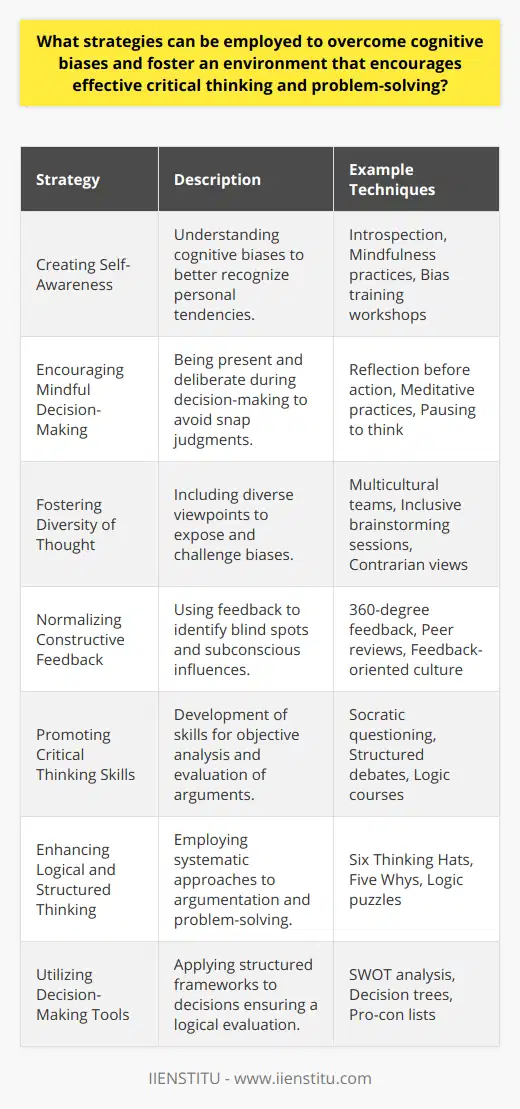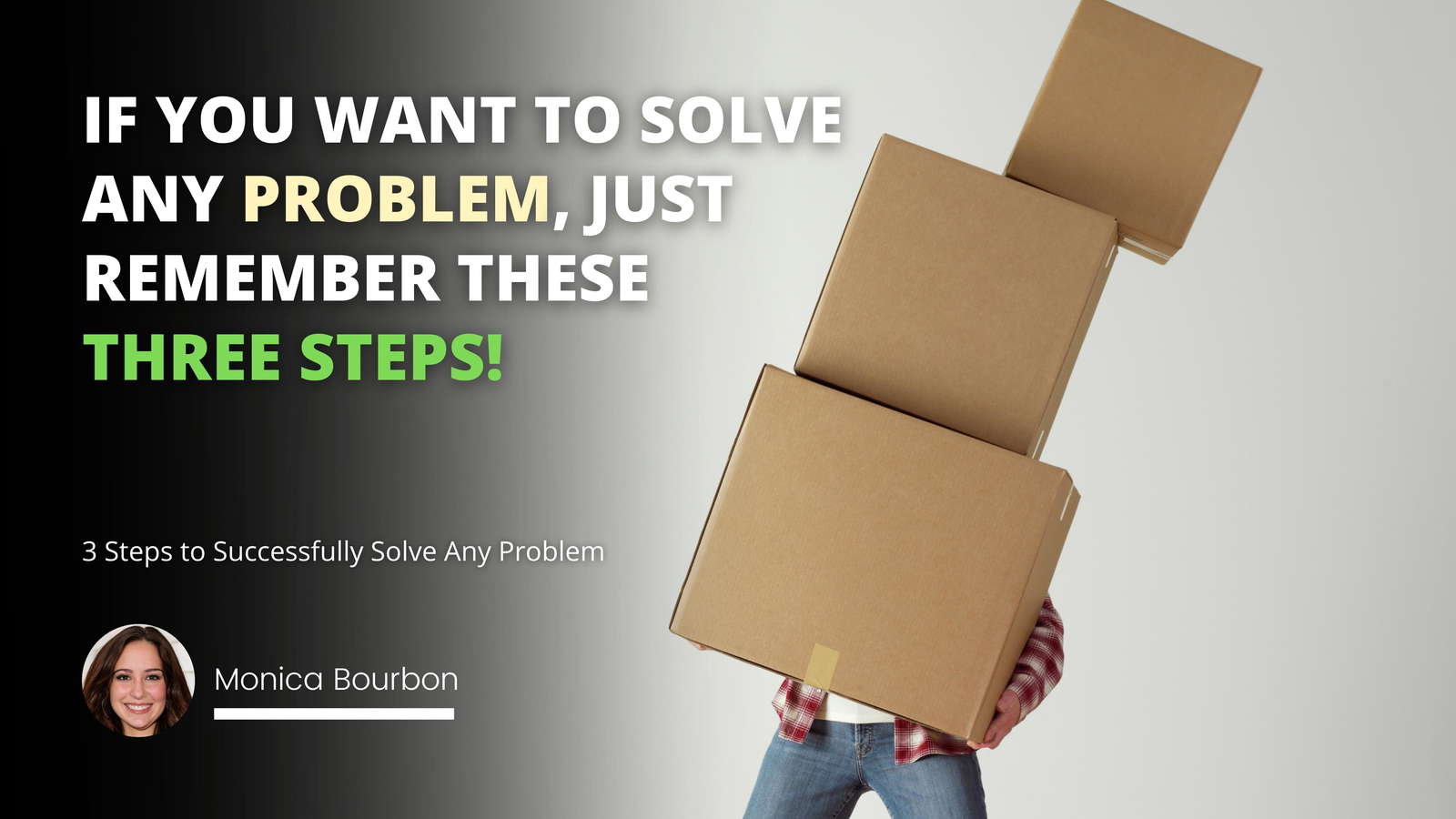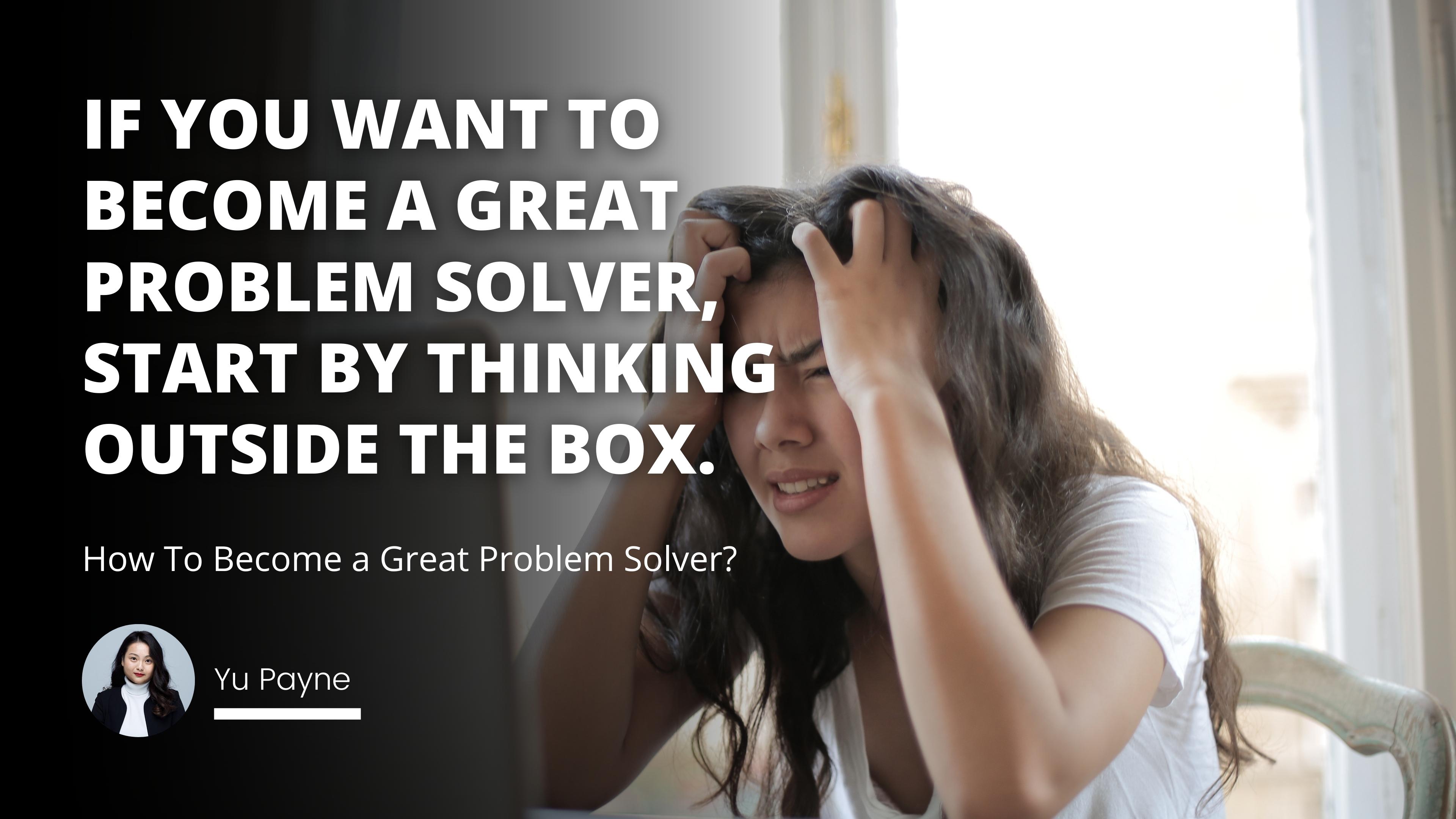
Have you ever found yourself staring at a problem, not knowing where to start? I remember a time back in college when I was working on a group project. We were tasked with developing a new product idea, and frankly, we were stuck. We had brainstorming sessions that led nowhere, and each meeting felt more unproductive than the last. It wasn't until one of my teammates suggested we take a step back and break the problem down that things started to click. That experience taught me firsthand the value of critical thinking and problem-solving skills.
Critical thinking and problem-solving are more than just buzzwords; they're essential skills that can transform the way we approach challenges in our lives. Whether you're a student grappling with complex subjects, an entrepreneur navigating the business world, or someone who simply wants to make better decisions, honing these abilities can make a significant difference.
Understanding the Importance of Critical Thinking
At its core, critical thinking involves analyzing information objectively and making reasoned judgments. It's about questioning ideas rather than accepting them at face value. I recall reading in "Thinking, Fast and Slow" by Daniel Kahneman how our minds often take shortcuts, leading to biases in our thought processes [^1]. By being aware of these tendencies, we can work towards more logical and rational thinking.
Techniques to Enhance Critical Thinking and Problem-Solving Skills
So, how do we develop these skills? There are several strategies you can incorporate into your daily life:
Pay Attention to Detail
One of the first steps is to pay attention to detail. This doesn't mean getting bogged down by minutiae but rather being thorough in how you assess a situation.
Observe carefully: Take time to notice the finer points.
Ask questions: If something doesn't make sense, don't hesitate to dig deeper.
In one of my previous jobs, I was responsible for preparing reports. Initially, I would often miss small errors, which led to bigger problems down the line. By cultivating a habit of meticulous review, not only did the quality of my work improve, but I also became more confident in my abilities.
Seek Out Different Perspectives
It's easy to get trapped in our own way of thinking. That's why it's crucial to seek out different perspectives.
Engage in discussions with people from diverse backgrounds.
Read extensively on various subjects.
Be open to feedback, even if it challenges your viewpoints.
I once worked with a team where everyone had vastly different opinions. At first, it was chaotic, but we soon realized that our diversity was our strength. By combining our different perspectives, we came up with innovative solutions we wouldn't have thought of individually.
Ask Questions
Never underestimate the power of asking questions.
1- Clarify: Ensure you understand the problem fully.
2- Probe deeper: Go beyond the surface answers.
3- Challenge assumptions: Don't accept things just because "that's how it's always been."
In my experience, the phrase "there are no stupid questions" holds true. Every query can lead to new insights, and sometimes, a simple question can uncover a fundamental flaw in an approach.
Practice Mindfulness
Mindfulness isn't just about meditation; it's about being present and fully engaged with whatever you're doing.
Focus on the task at hand.
Acknowledge distractions but let them pass without dwelling.
Reflect on your thoughts and feelings objectively.
According to Jon Kabat-Zinn in his book "Wherever You Go, There You Are", mindfulness can help reduce stress and improve cognitive functions [^2]. By practicing mindfulness, we can clear our minds, making room for more deliberate and effective thinking.
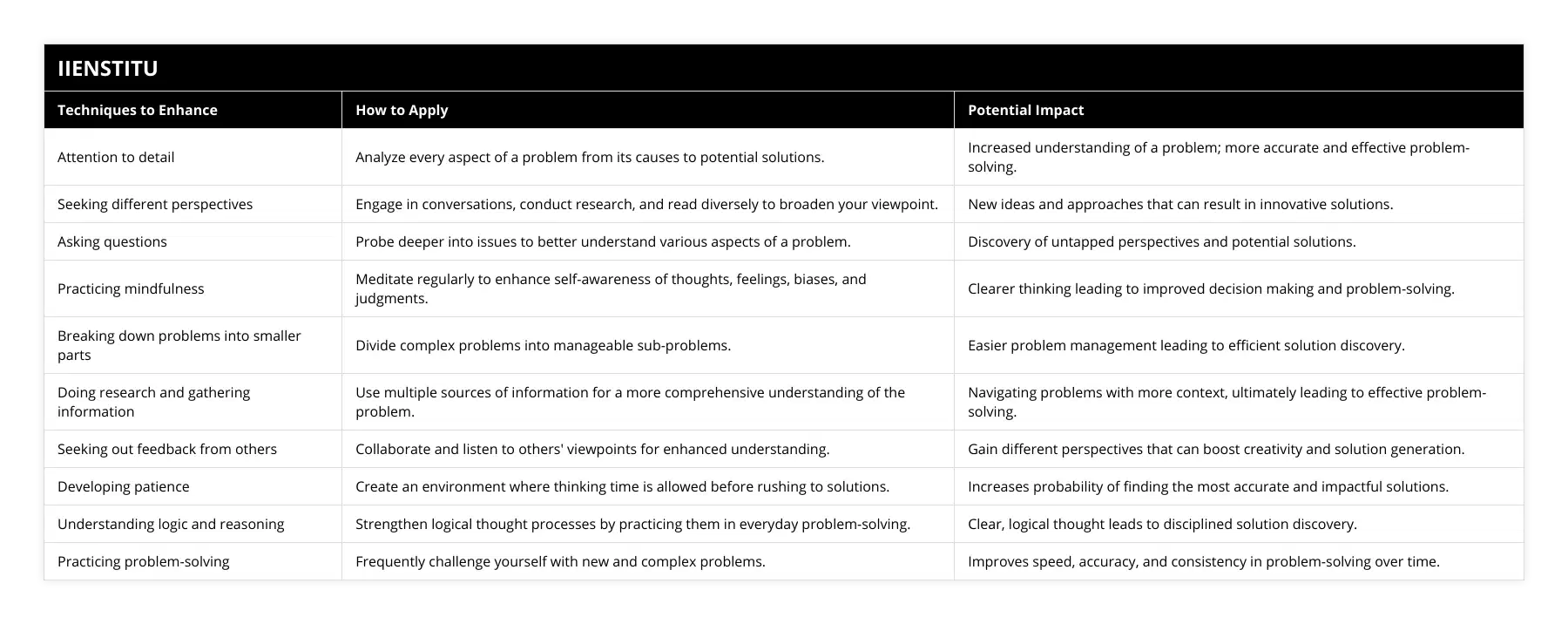
Embrace the Learning Process
Remember that critical thinking and problem-solving are skills that can be developed over time.
Be patient with yourself.
Set small goals to track your progress.
Celebrate your successes, no matter how minor they seem.
I used to get frustrated when I couldn't solve a problem immediately. Over time, I learned to appreciate the journey of learning. Each challenge became an opportunity to grow, rather than an obstacle to overcome.
Overcoming Common Barriers to Critical Thinking
We all face obstacles when trying to think critically. Recognizing and overcoming these barriers is crucial.
Confirmation Bias
One major obstacle is confirmation bias, where we favor information that confirms our existing beliefs.
Be aware of your biases by reflecting on your beliefs.
Seek out contradictory information to challenge your viewpoints.
For instance, I used to firmly believe that multitasking was the key to productivity. However, after reading "The Myth of Multitasking: How 'Doing It All' Gets Nothing Done" by Dave Crenshaw [^3], I realized that multitasking can actually hinder efficiency.
Overgeneralization
Another barrier is overgeneralization—drawing broad conclusions from limited evidence.
Avoid making assumptions based on a small sample size.
Collect ample data before arriving at a conclusion.
In one of my projects, we noticed a slight dip in user engagement on our website. Initially, we thought it was due to a new design. However, by conducting thorough research, we discovered it was a temporary issue caused by external factors.
Developing Critical Thinking in Students
For educators and parents, developing critical thinking in students is paramount.
Encourage questioning: Allow students to ask "why" and "how."
Promote problem-based learning: Present real-world problems for students to solve.
Foster a growth mindset: Praise effort and learning over innate ability.
According to Paul and Elder in "Critical Thinking: Tools for Taking Charge of Your Learning and Your Life", teaching critical thinking skills can empower students to take control of their education [^4].
The Importance of Critical Thinking in Everyday Life
Critical thinking isn't just for academics or professionals; it's vital in our daily lives.
Make better decisions: From choosing what to buy to managing personal relationships.
Solve everyday problems: Like fixing household issues or planning events.
Navigate information overload: In an age of endless information, discernment is key.
I remember when I was deciding on a major purchase—a new car. By applying critical thinking, I weighed the pros and cons, researched extensively, and ultimately made a choice that I'm still happy with today.
Mindfulness Exercises for Better Thinking
To enhance your thinking abilities, mindfulness exercises can be beneficial.
Deep breathing: Helps center your thoughts.
Mindful observation: Focus on an object and notice its details.
Body scan meditation: Increases awareness of physical sensations.
In "The Miracle of Mindfulness", Thich Nhat Hanh emphasizes that mindfulness can improve concentration and clarity [^5].
Techniques for Effective Problem Solving
Beyond critical thinking, knowing specific techniques for effective problem solving can be a game-changer.
The Five Whys Technique
This involves asking "why" five times to get to the root cause of a problem.
Identify the problem.
Ask why it occurred.
Repeat until the underlying issue is uncovered.
SWOT Analysis
Assess the Strengths, Weaknesses, Opportunities, and Threats related to a situation.
1- Strengths: What advantages do you have?
2- Weaknesses: Where can you improve?
3- Opportunities: What possibilities are open to you?
4- Threats: What obstacles do you face?
I used SWOT analysis when contemplating a career change. By laying everything out, I was able to make an informed decision that aligned with my goals.
Enhancing Problem-Solving Abilities Over Time
Improving problem-solving skills is an ongoing process.
Reflect on past problems: What worked and what didn't?
Learn new methodologies: Stay updated with the latest tools and techniques.
Practice regularly: Like any skill, practice makes perfect.
Applying These Skills in Everyday Life
It's one thing to know these strategies, but how do we apply them in real-life situations?
In Academic Settings
For students, developing critical thinking is essential.
Analyze topics deeply rather than memorizing facts.
Participate in discussions and debates.
Apply concepts to practical examples.
By focusing on how to improve critical thinking skills, students can enhance their learning experience and prepare for future challenges.
In the Workplace
Professionals can benefit immensely from enhanced problem-solving abilities.
Collaborate with colleagues to find solutions.
Innovate by thinking outside the box.
Lead by example, demonstrating effective thinking skills.
I recall a project where we needed to cut costs without sacrificing quality. By assembling a cross-functional team and encouraging open dialogue, we identified inefficiencies and implemented improvements that saved the company significant resources.
In Personal Life
Even outside work or school, these skills are invaluable.
Make informed decisions about finances, health, and relationships.
Resolve conflicts by understanding different viewpoints.
Plan ahead by anticipating potential challenges.
The Role of Mindfulness in Enhancing Thinking
Mindfulness deserves a special mention. In a world that's constantly buzzing, taking the time to be present can seem challenging. However, the benefits are profound.
Reduces stress, allowing for clearer thinking.
Improves focus, enabling you to process information better.
Enhances creativity, opening up new avenues of thought.
According to a study published in the Journal of Cognitive Enhancement, regular mindfulness practice can lead to improvements in problem-solving skills and cognitive flexibility [^6].
A Note on Reassignment Request Letters
On a slightly different note, if you're considering making changes in your professional life, such as requesting a job reassignment, reassignment request letter tips and information can be incredibly valuable. Applying critical thinking to such a situation can help you articulate your reasons effectively, anticipate potential objections, and present solutions that benefit both you and your employer.
Long-Term Benefits of Developing These Skills
Investing time in improving your critical thinking and problem-solving abilities can lead to long-term benefits.
Career advancement: Employers value individuals who can think critically and solve problems efficiently.
Personal growth: You'll be better equipped to handle life's challenges.
Better relationships: Effective communication and understanding lead to stronger connections with others.
How to Start Today
Feeling inspired? Here are some steps you can take immediately:
1- Set aside time each day for reflection.
2- Engage in activities that challenge your thinking, like puzzles or reading complex material.
3- Join groups or forums where critical discussions take place.
4- Practice mindfulness techniques, such as deep-breathing exercises or meditation.
5- Seek feedback from peers or mentors on your decision-making processes.
6- Stay curious and never stop asking questions.
Bringing It All Together
In today's fast-paced world, the ability to think critically and solve problems effectively is more important than ever. By focusing on enhancing problem-solving abilities and developing critical thinking in students and ourselves, we are better equipped to handle the complexities of modern life.
Whether it's the importance of critical thinking in everyday life or applying mindfulness exercises for better thinking, the strategies discussed can have a profound impact. By improving critical thinking skills, we not only enhance our personal and professional lives but also contribute positively to the communities we're part of.
Conclusion
Developing strong critical thinking and problem-solving skills is a journey, not a destination. It's about continuously challenging yourself, being open to new ideas, and embracing the learning process. As I've learned through my own experiences, the effort you put in now will pay dividends in the future.
So, why wait? Start integrating these strategies into your daily life, and watch as you become a more effective thinker and problem-solver. The challenges you face will become opportunities, and your goals will become that much more attainable.
[^1]: Kahneman, D. (2011). Thinking, Fast and Slow. Farrar, Straus and Giroux.
[^2]: Kabat-Zinn, J. (1994). Wherever You Go, There You Are: Mindfulness Meditation in Everyday Life. Hyperion.
[^3]: Crenshaw, D. (2008). The Myth of Multitasking: How "Doing It All" Gets Nothing Done. Jossey-Bass.
[^4]: Paul, R., & Elder, L. (2014). Critical Thinking: Tools for Taking Charge of Your Learning and Your Life. Pearson.
[^5]: Hanh, T. N. (1975). The Miracle of Mindfulness. Beacon Press.
[^6]: Alberts, H. J., & Hülsheger, U. R. (2016). Applying mindfulness in the context of work: Mindfulness-based interventions. In Journal of Cognitive Enhancement, 1(1), 1-12.
Frequently Asked Questions
What is critical thinking, and what are some common misconceptions about it?
Critical thinking is the ability to analyze information and make decisions using logic, reason, and evidence. Some common misconceptions about critical thinking include the idea that it is simply a way of thinking or an innate skill that cannot be taught or developed, or that it requires complex analytical skills or subject-specific knowledge. In reality, however, anyone can cultivate their critical thinking abilities with practice and effort.
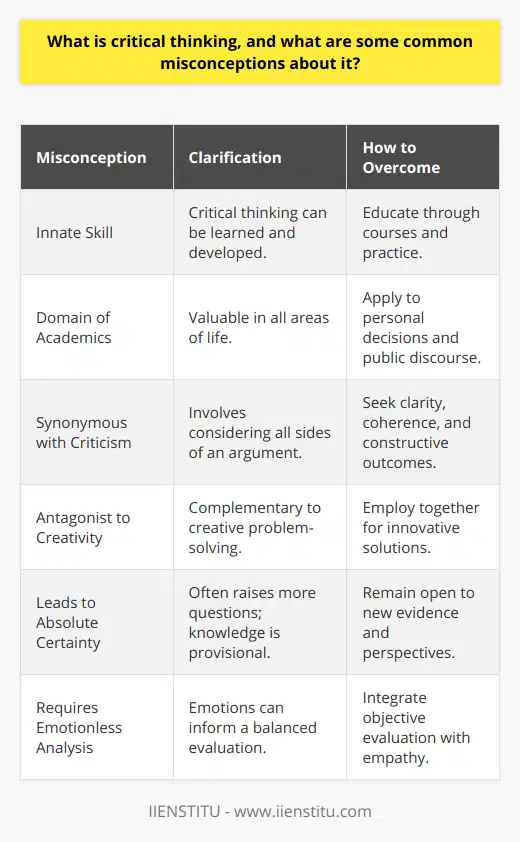
How can I improve my critical thinking skills?
There are many different strategies and techniques you can use to improve your critical thinking skills. These may include breaking down problems into smaller parts, gathering information and research from multiple sources, looking for patterns and inconsistencies in information, and being open to new ideas and perspectives. Additionally, it can be helpful to practice mindfulness and meditation, which can help you approach problems with a clear mind and unbiased perspective.
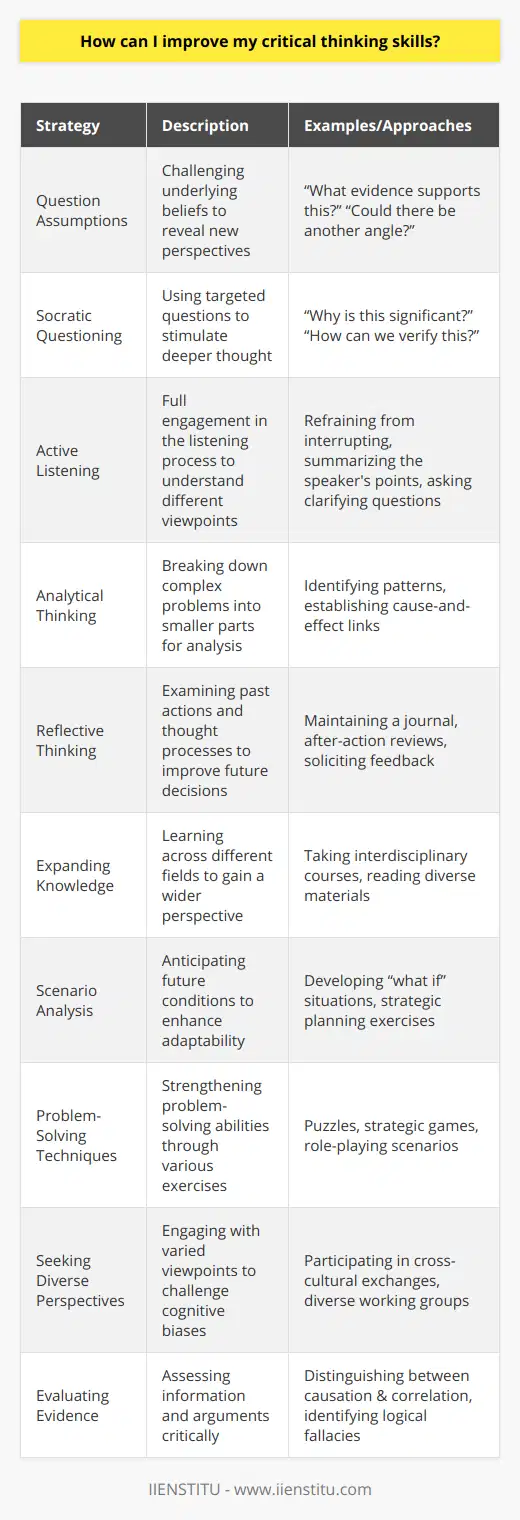
What are some common challenges or obstacles that may get in the way of critical thinking?
Some common challenges that may interfere with critical thinking include cognitive biases like confirmation bias or sunk cost fallacy, as well as social or emotional factors like fear, anxiety, or stress. It is important to recognize these potential obstacles and take steps to overcome them in order to think more clearly and effectively when faced with a problem or challenge.

How can I apply critical thinking skills to my work or professional life?
One effective way to apply critical thinking skills in your professional life is to approach projects or tasks with an analytical mindset, breaking them down into smaller parts and seeking out different perspectives. Additionally, being proactive about identifying and overcoming cognitive biases like groupthink or sunk cost fallacy can help you make more objective and informed decisions when working on a team or collaborating with others.
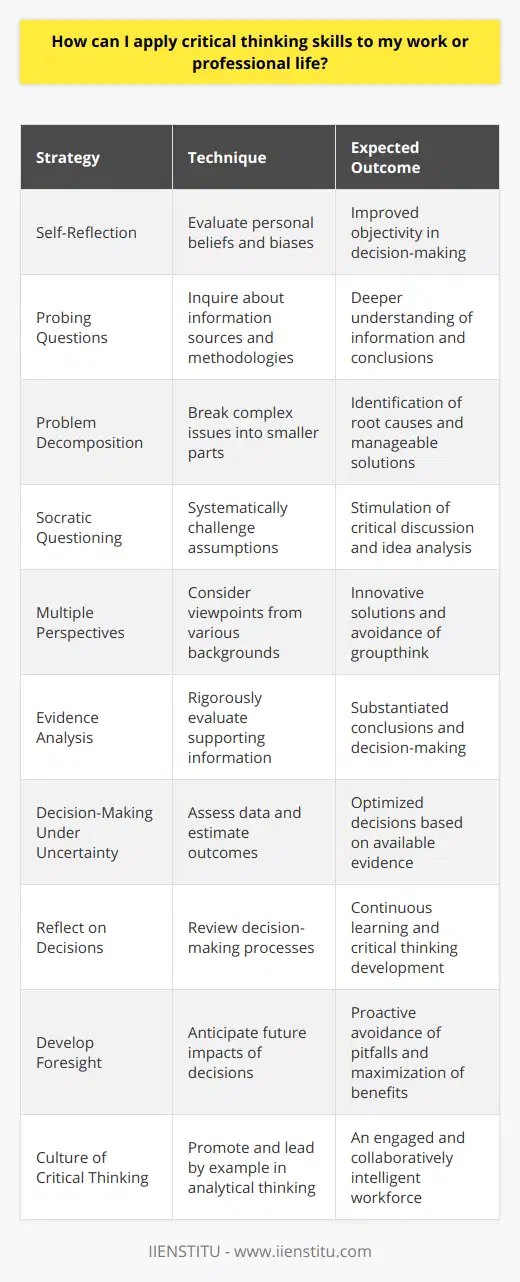
What are some success stories of people who have used critical thinking and problem-solving skills in their work or personal lives?
There are many notable examples of individuals who have used critical thinking and problem-solving skills to achieve great success in their work or personal lives. For example, Steve Jobs was a highly innovative entrepreneur known for his creative problem-solving approach and ability to see things from a different perspective. Another example is Elon Musk, who has used critical thinking skills to build several successful businesses and revolutionize various industries through his innovative technologies.
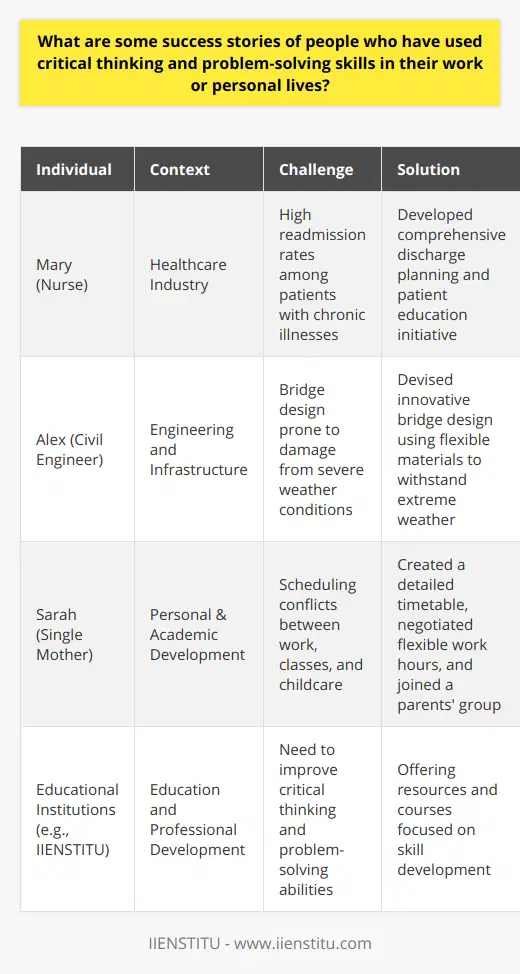
How can I continue developing and honing my critical thinking skills over time?
There are many ways that you can continue to develop and refine your critical thinking skills over time, such as actively seeking out new learning opportunities, reading widely, practicing mindfulness and meditation, taking classes or workshops on critical thinking topics, or joining a professional organization or community of like-minded thinkers. With consistent effort and dedication, you can become a more effective critical thinker – no matter what challenges may come your way in life.

What are the essential components of the 5-step process to improve critical thinking?
Introduction
Critical thinking is integral to effective decision-making, problem-solving, and understanding complex issues. Developing these skills requires a systematic approach, such as the 5-step process which entails five essential components.
Step 1: Identify the Problem or Question
The first component centers on clearly defining the issue or question under investigation. This involves identifying assumptions, biases, and any initial thoughts related to the problem, ensuring that the focus remains on addressing the intricate details throughout the process.
Step 2: Gather Information
In this step, various sources are consulted to collect relevant facts, ideas, and evidence pertaining to the identified problem. These sources should be reliable, diverse, and accurate, encompassing various perspectives and offering a comprehensive understanding of the issue.
Step 3: Evaluate and Analyze
Once the information is gathered, it becomes essential to systematically evaluate and analyze the collected evidence. This step demands a critical evaluation of the credibility, relevance, and sufficiency of the gathered material. Additionally, it requires the ability to identify patterns, trends, and possible correlations.
Step 4: Synthesize and Develop Insights
With the evidence evaluated, the next step is to synthesize and develop insights by connecting the gathered content in a meaningful manner. Contrasting and comparing viewpoints, drawing conclusions, and identifying any gaps in information are crucial to fostering a comprehensive understanding of the issue.
Step 5: Communicate and Apply Solutions
The final component is to effectively communicate and apply the newfound knowledge and insights to solve the problem or answer the question. This involves organizing the information in a logical, coherent manner to devise appropriate solutions, and sharing them with relevant stakeholders, thereby demonstrating the effective application of critical thinking skills.
Conclusion
The 5-step process to improve critical thinking serves as a structured framework to address complex issues or questions systematically. By adopting this approach, individuals can enhance their ability to identify problems, gather and evaluate information, synthesize insights, and communicate and apply rational solutions. As a result, critical thinking skills become an indispensable tool for success in various professional and personal contexts.
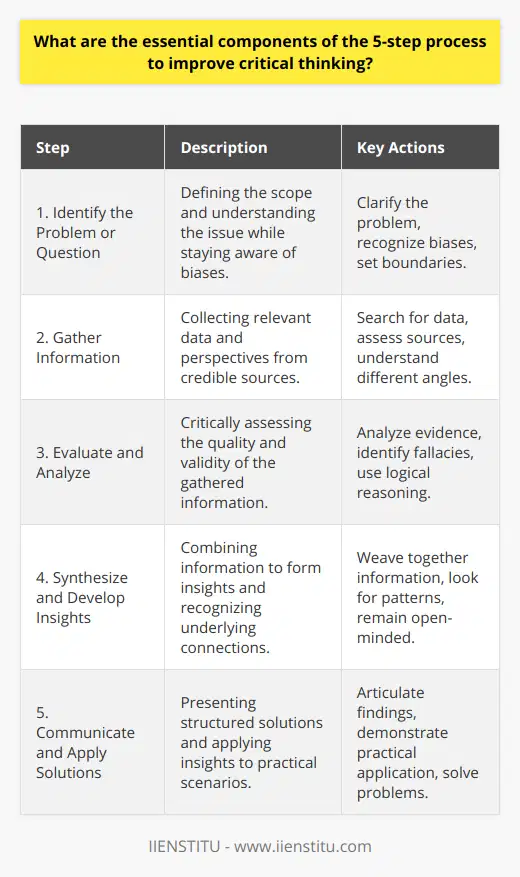
How can engaging in reflective practice contribute to the enhancement of my thinking skills?
Analyzing Personal Experiences
Reflective practice, a systematic process of analyzing and evaluating personal experiences, can significantly contribute to the enhancement of one's thinking skills. By engaging in this process, individuals can develop a deeper understanding of the factors that shaped their actions and decisions, ultimately promoting metacognition, i.e., the awareness and management of one's thought process.
Developing Critical Thinking
Moreover, reflective practice fosters critical thinking, an essential skill that involves analyzing information, assessing its value and relevance, and constructing logical arguments and conclusions. By critically examining their experiences, individuals can identify their personal biases, assumptions, and errors, paving the way for improved decision-making and problem-solving abilities.
Promoting Open-Mindedness
In addition, engaging in reflective practice encourages open-mindedness, as it requires individuals to question personal beliefs, accept constructive criticism, and recognize alternative perspectives. This openness allows them to better adapt to new situations, enhance their decision-making capacity, and foster a positive attitude towards continuous learning.
Stimulating Creativity
Furthermore, reflective practice stimulates creativity by supporting the exploration of new ideas and approaches, and inspiring individuals to challenge existing norms and assumptions. As a result, they can develop innovative solutions and strategies to address both personal and professional problems, leading to overall intellectual growth.
Cultivating Emotional Intelligence
Lastly, reflective practice plays an instrumental role in cultivating emotional intelligence, a crucial aspect of interpersonal and intrapersonal relationships, and effective communication. Through self-examination, individuals can explore their emotions, recognize patterns in their behavior, and develop better strategies to manage emotions, thus enhancing their emotional intelligence.
In conclusion, engaging in reflective practice leads to an improvement in various thinking skills, such as critical thinking, open-mindedness, creativity, and emotional intelligence. By adopting this approach, individuals can foster a deeper understanding of themselves, their experiences, and the world around them, ultimately leading to personal and professional growth.

Can you provide a real-world example that showcases the application of critical thinking and problem-solving techniques in a challenging situation?
Real-World Example: Medical Diagnosis
Critical Thinking in Practice
A compelling example of critical thinking and problem-solving application in a challenging situation can be found in medical diagnosis. Healthcare professionals encounter an array of complex clinical scenarios daily, requiring analytical skills and informed decision-making.
Identifying the Problem
Initially, a physician must scrutinize diverse symptoms presented by the patient during the consultation. Gathering relevant patient history, blood tests, and imaging studies involve critical thinking to identify potential health issues or patterns that demand further investigation.
Eliminating Hypotheses
To establish an accurate diagnosis, medical professionals systematically analyze all available evidence, making critical judgments to exclude alternate hypotheses based on scientific reasoning. They must also consider external factors and their influence on the patient's condition, highlighting the importance of interdisciplinary knowledge.
Considering Probabilities
Subsequently, medical professionals weigh the probabilities of each hypothesis, using statistical data and previous experiences. Critical thinking is crucial in determining not only the most plausible diagnosis but also alternative possibilities.
Evaluating Solutions
Throughout the decision-making process, healthcare experts must continuously evaluate the effectiveness and potential consequences of various treatments. By applying critical thinking and problem-solving techniques, medical professionals can make informed decisions about the risks and benefits of available treatments to ultimately improve patient outcomes.
Consulting and Collaborating
Furthermore, medical professionals often engage in consultations and collaboration with colleagues to broaden their perspective and consider innovative solutions. This collaboration exemplifies the application of critical thinking, as it involves evaluating various opinions, dissecting conflicting information, and fostering open-mindedness in developing consensus.
Adapting under Pressure
Lastly, healthcare personnel must also demonstrate cognitive flexibility and the ability to adapt to unexpected challenges. In a high-stakes environment, medical professionals balance critical thinking and problem-solving techniques with decisiveness and swift action, especially in emergency situations.
Conclusion
The medical diagnosis process epitomizes critical thinking and problem-solving aptitude, illustrating its significance in adapting to challenging situations. Healthcare professionals' ability to synthesize information, consider multiple outcomes, and make informed decisions showcases the power of such techniques, leading to improved patient care and outcomes.

What are the five easy steps to improve your critical thinking skills?
**Identifying the Five Steps**
In order to enhance one's critical thinking abilities, it is crucial to follow a systematic process comprising five easy steps. These steps include identifying biases, asking questions, examining evidence, considering alternative perspectives, and evaluating potential outcomes.
**Recognizing Biases**
The first step towards improving critical thinking skills is to identify and acknowledge one's own biases, as well as understand how they may affect decision-making. By recognizing personal beliefs, opinions, and values, individuals can work to counteract the influence of biases on their thought processes.
**Questioning Assumptions**
Next, it is essential to ask questions and challenge assumptions in order to better understand different viewpoints and gather more information. Formulating questions and seeking clarification on specific topics promotes critical thinking and fosters the development of well-informed opinions.
**Examining Evidence**
Following the questioning stage, it is important to carefully examine the evidence available for a particular issue. By scrutinizing evidence, individuals can analyze the credibility, relevance, and accuracy of information, ultimately allowing them to construct well-informed assessments and conclusions.
**Exploring Alternative Perspectives**
Another critical step is to consider alternative viewpoints, opinions, and possible solutions. By doing so, individuals broaden their understanding of the issue at hand and can more effectively evaluate the strengths and weaknesses of each perspective. This, in turn, allows them to form a more rounded and balanced overall conclusion.
**Evaluating Outcomes**
Lastly, evaluating potential outcomes is a crucial step in fostering critical thinking skills. By weighing the potential consequences of various choices, individuals can better understand the implications of their decisions and make the most appropriate and beneficial decision.
In conclusion, enhancing critical thinking skills is a multi-step process that involves identifying biases, asking questions, examining evidence, considering alternative perspectives, and evaluating possible outcomes. By following these steps, individuals improve their understanding of complex issues and ultimately develop more informed and balanced opinions.
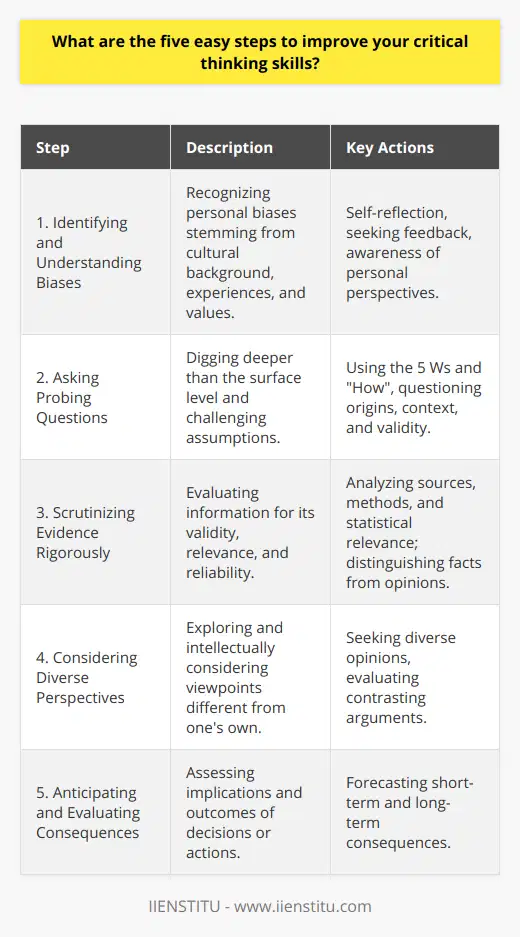
How can you improve your critical thinking and problem solving?
Developing Critical Thinking Skills
To enhance critical thinking abilities, one must first cultivate a curious and questioning mindset. This involves asking pertinent questions about various topics and seeking diverse perspectives to gain a comprehensive understanding of the subject matter. Engaging in debates or discussions, reading broadly across disciplines, and actively seeking feedback helps sharpen the analytical focus.
Embracing Intellectual Humility
An important aspect of improving critical thinking is to recognize and embrace intellectual humility. By acknowledging limitations in one's knowledge and being open to new information, individuals can continue tolearn and grow. Intellectual humility fosters a desire to pursue truth, even when it contradicts one's preconceived notions, which ultimately leads to better problem-solving abilities.
Applying Logic and Reasoning
To sharpen problem-solving skills, one must consistently apply logic and reasoning to diverse situations. This can be achieved by breaking down complex issues into simpler components, analyzing relationships between variables, and identifying assumptions or biases. Developing mental models and using frameworks, such as the scientific method, can also aid in structured problem-solving.
Evaluating Evidence
Critical thinkers must be able to evaluate the quality and relevance of evidence. Doing so involves assessing sources for reliability, objectivity, and credibility. Moreover, understanding the distinction between correlation and causation, and recognizing common logical fallacies, will help in accurately interpreting information and making sound judgments.
Reflection and Self-assessment
Lastly, regular reflection and self-assessment are integral to enhancing critical thinking and problem-solving capabilities. By reviewing past decisions and thought processes, individuals can identify areas for improvement and refine their approach to problem-solving. Practicing metacognition, or thinking about one's thinking, helps in recognizing cognitive errors, biases, and blind spots, ultimately contributing to overall growth and development.
In conclusion, improving critical thinking and problem-solving skills necessitates conscious effort, reflection, and practice. By cultivating an inquisitive mindset, embracing intellectual humility, applying logic and reasoning, evaluating evidence, and engaging in self-assessment, individuals can sharpen their analytical abilities and enhance their decision-making prowess.
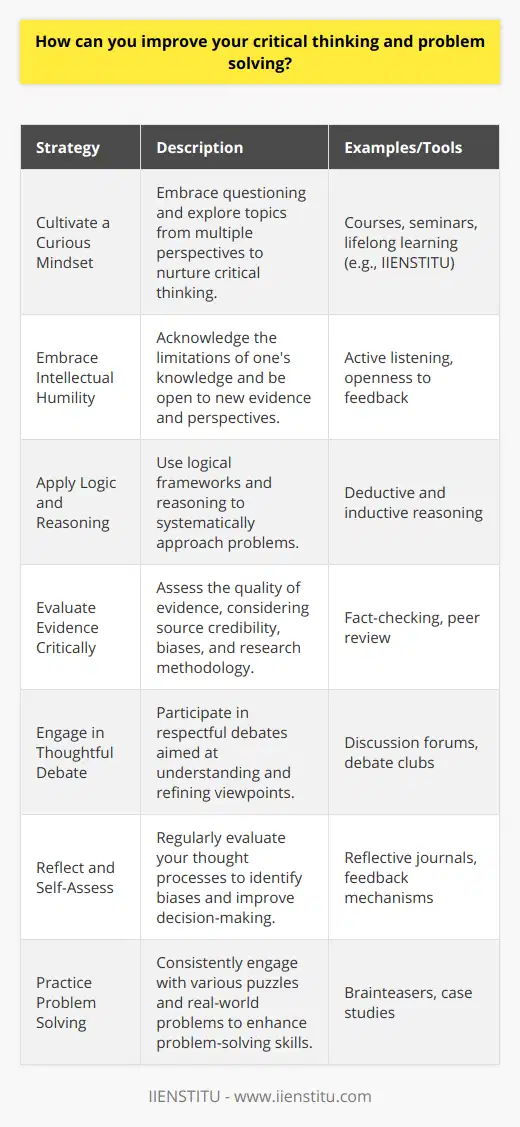
What is an example of critical thinking and problem solving?
Example of Critical Thinking and Problem Solving
Application in Everyday Scenarios
One compelling example of critical thinking and problem solving can be found in the realm of blog posts. As online platforms have surged in popularity over recent years, discerning readers have become increasingly adept at determining the credibility of various sources. By utilizing critical thinking skills to systematically analyze and evaluate arguments, and then applying problem-solving abilities to overcome potential pitfalls, individuals can navigate through the vast landscape of digital information and ensure that they only absorb information from accurate and reputable sources.
Assessing Blog Post Credibility
In order to ascertain the credibility of a blog post, its author's motivations, potential biases, and expertise on the chosen subject must be considered. For example, an article discussing the merits of a new dietary supplement should be scrutinized if the author works for the company that produces the supplement or if their educational qualifications are not aligned with the health and wellness industry.
Importance of Reliable Sources
Additionally, a critical thinker will look towards the inclusion of evidence and information that supports the blog post's claims. By seeking out links to reputable sources and confirming that these sources maintain the same level of accuracy and credibility, the reader can validate the blog post's quality. This vigilance towards supporting sources helps avoid falling into the trap of misinformation disseminated by blogs with sinister intentions or lacking expertise.
Identifying Logical Fallacies
Recognizing logical fallacies can also be a crucial aspect of critical thinking when examining blog posts. Logical fallacies are errors in reasoning, usually as a result of bias or manipulation, which ultimately undermine the validity of a given argument. For instance, a blog post may argue that a certain political ideology is incorrect by attacking the character of proponents of that ideology rather than disproving their ideas. By analyzing the strength of the argument and avoiding the influence of logical fallacies, readers can form well-founded conclusions based on the true merits of each perspective.
Problem Solving in the Digital Age
In summary, the combination of critical thinking and problem solving enables individuals to navigate the complex world of online information by assessing the credibility of blog posts and their sources. By considering the author's motivations and qualifications, scrutinizing supporting evidence, and recognizing logical fallacies in presented arguments, readers can make informed decisions about which blogs to invest their time and trust in. This is an essential skill in interpreting and utilizing knowledge in the digital age, where misinformation and biased perspectives can easily be perpetuated through online platforms.

What are the foundational principles of critical thinking, and how do they relate to effective problem solving?
Understanding Critical Thinking Principles
The foundational principles of critical thinking are clarity, precision, accuracy, consistency and relevance. These principles foster a comprehensive understanding of the situation at hand. They require thinkers to express an idea clearly, precisley and with accuracy. Additionally, they must maintain consistency in their thought process, and all information or arguments used must be relevant.
Linking Principles to Problem-Solving
In terms of effective problem-solving, these principles are fundamental for formulating viable solutions. Clarity, for example, allows for a precise definition of the problem, detangling any complexities. Precision and accuracy further ensure the correct interpretation and identification of the underlying issues. On the other hand, consistency avoids contradictory thinking, ensuring that the solution strategy remains on the right path. Lastly, focus on relevance eliminates unnecessary distractions, allowing for an effective approach towards solving the problems.
Assessing Facts and Understanding Implications
Critical thinking principles also involve assessing the factual information before generating solutions. One must determine the reliability of facts, avoiding assumptions or misconceptions. To understand the implications of the proposed solutions, one must gauge the consequences and repercussions. Adequate consideration of these factors ensure that solutions are not just effective, but also sustainable.
Reflective Thinking and Self-Correction
One of the most notable aspects of critical thinking involves reflective thought and self-correction. A critical thinker must always be open to question his/her thought process, reflect on the work done and rectify any errors or loopholes. This constant loop of self-correction eventually leads to an optimized problem-solving process.
In conclusion, the principles of critical thinking are significantly intertwined with effective problem-solving. By applying these principles in the right manner, one can significantly enhance their problem-solving capabilities. Critical thinking is not merely a skill; it's an indispensable mindset to actively understand and interact with the world.

In what ways can cognitive biases impede our critical thinking and problem-solving abilities, and how can we mitigate their effects?
Impact of Cognitive Biases on Critical Thinking
Cognitive biases can significantly hinder critical thinking and problem-solving abilities. These biases can distort our perception, leading us to favor or reject ideas based on our preconceived notions, rather than objective evidence. For instance, confirmation bias, where we seek information that confirms our pre-existing beliefs, can limit our capacity to analyze all sides of an argument objectively.
Disrupting Problem-Solving Capacity
Similarly, other biases like anchoring bias and availability heuristic can obstruct effective problem-solving. Anchoring bias, which depends on the first piece of information encountered, may cause us to overlook important data and reach faulty conclusions. Availability heuristic, with its tendency to rely on readily available information, can result in superficial evaluations and hasty decisions.
Mitigating Cognitive Biases in Decision-Making
Shouldering the responsibility to mitigate these biases requires self-awareness and mental discipline. Reflection on our thought patterns and decision-making processes will identify any potential cognitive biases, providing an opportunity for correction. Striving for a balanced view by proactively seeking out alternative perspectives, testing hypotheses, and evaluating evidence objectively, can also help counteract these biases.
Promoting Critical Thinking and Problem-Solving Abilities
Regular exposure to diverse viewpoints and constant challenging of our beliefs can enhance critical thinking. These methods can keep cognitive biases in check and promote a more nuanced approach to problem-solving. The practice of mindfulness too actively helps to prevent immediate reaction to information and allows deeper, more thoughtful analysis.
In conclusion, while cognitive biases pose a genuine challenge to critical thinking and problem-solving, conscious efforts to identify and mitigate them can significantly bolster our decision-making abilities. It is crucial for us, both individually and collectively, to remain vigilant against these biases for effective and objective problem-solving.
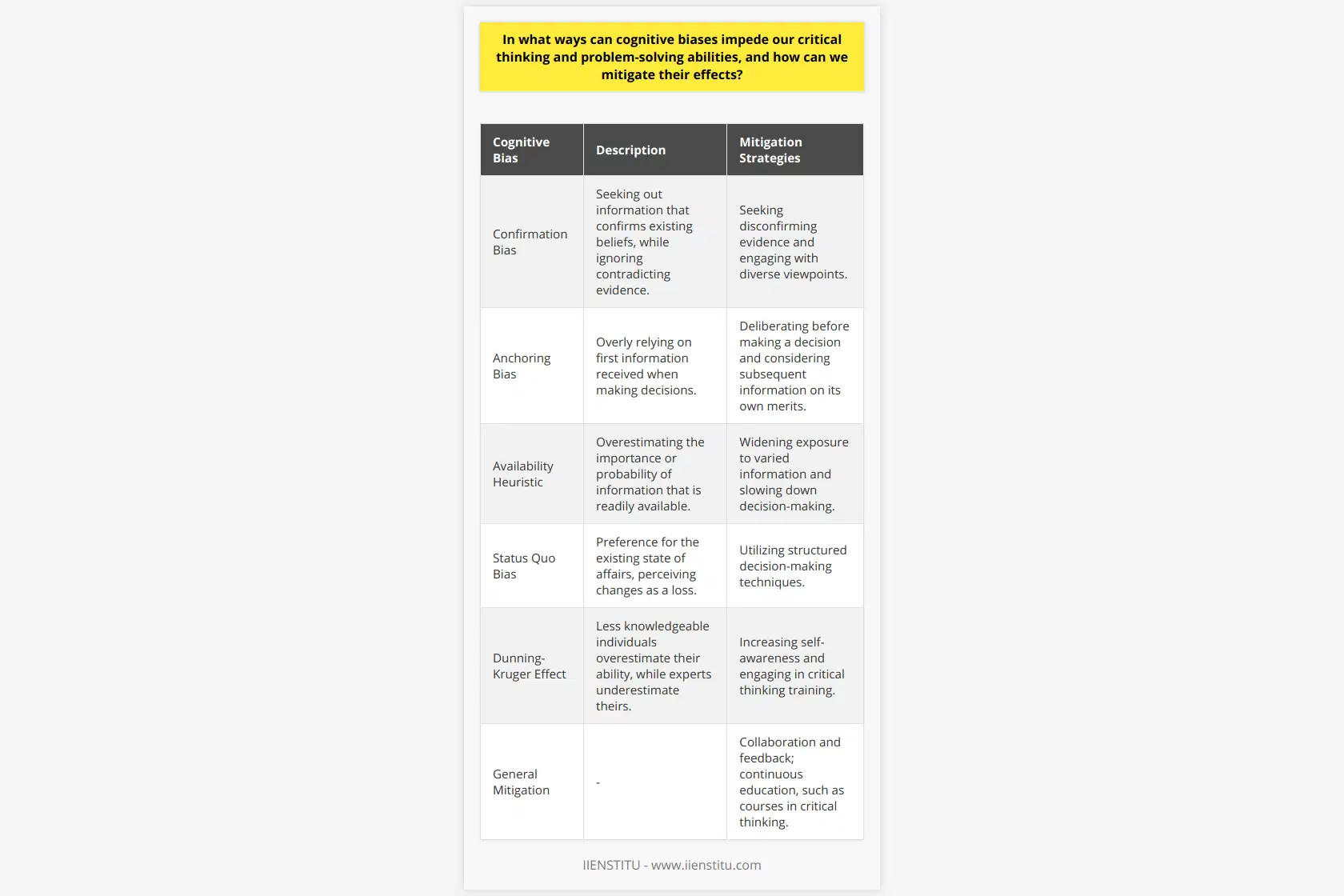
How can collaborative and interdisciplinary approaches enhance critical thinking and problem-solving outcomes?
Promotion of Collaborative Efforts
Collaborative strategies can significantly enhance critical thinking and problem-solving skills. They compel individuals to communally scrutinize, and challenge ideas, therefore, promoting critical assessment of different perspectives. In group settings, members deduce solutions through discussions, negotiations, and sometimes through conflicts, which aids in developing their analytical skills.
Role of Interdisciplinary Practices
Incorporating interdisciplinary approaches can also enrich these outcomes. Interdisciplinary learning obliges individuals to integrate knowledge from different disciplines, thus deepening their understanding and increasing their ability to view issues from multiple standpoints. It dissolves the boundaries between various disciplines, encouraging comprehensive problem-solving strategies.
Boosting Critical Thinking Skills
Both collaborative and interdisciplinary approaches essentially promote inquisitiveness, open-mindedness, and reflective thinking. They generate an environment where individuals continuously question and evaluate their own knowledge, as well as others’. This relentless interrogation nurtures the ability to critically analyze an issue, interpret different viewpoints, and construct cogent arguments.
Enhancing Problem-Solving Capabilities
Additionally, these approaches encourage individuals to deconstruct problems and structure solutions in a distilled manner. By incorporating teamwork and interdisciplinary learning, individuals become proficient in understanding complex problems holistically, considering all relevant aspects before forming a conclusion.
Moreover, these collaborative and interdisciplinary approaches foster creativity, as they invite diverse ideas on the table - varying from traditional to radical concepts. This diversity encourages innovative problem-solving techniques that can challenge the status-quo.
Endurance for Changes
Ultimately, these strategies not only enhance critical thinking and problem-solving aptitudes but also strengthen individuals' capacity to adapt to changing circumstances. By encouraging the acceptance and integration of different perspectives, they prepare individuals for an eclectic range of future scenarios and challenges.
In conclusion, collaborative and interdisciplinary approaches can significantly magnify critical thinking and problem-solving capabilities. Adopting these approaches can eventually foster a generation of creative thinkers and problem solvers, who are well-equipped to handle multifaceted challenges in their respective fields.
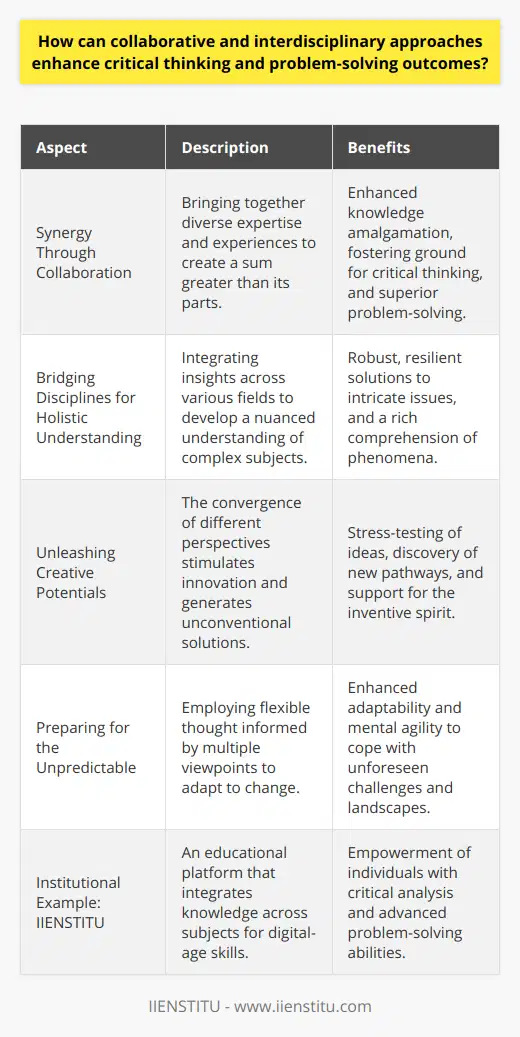
What are the 7 steps of the critical thinking process, and how do they contribute to successful problem solving?
Understanding the Critical Thinking Process
The first step of the critical thinking process is Identification, where the problem is recognized and defined clearly. Clarity at this stage sets the direction for the next steps. Following identification, analysis becomes crucial. During Analysis, the problem is systematically examined. This helps to understand the nature, context, and potential solutions.
Information Gathering and Evaluation
Next, the Information Gathering step involves the collection of data related to the problem. It is crucial to amass accurate, reliable information for successful problem solving. This will feed into the Evaluation phase where the gathered information undergoes a critical review to measure its relevance and reliability.
Solution Generation and Decision Making
Moving forward, the fifth step, Solution Generation, involves brainstorming various solutions. Each option should be carefully considered to ensure it effectively resolves the problem. After generating potential solutions, the next critical process is Decision Making. Here, the best solution is chosen based on evaluated evidence and logical reasoning.
Final Assessment and Reflection
Finally, the seventh step is the Final Assessment, where the selected solution is implemented and its effectiveness assessed. This step allows one to gauge whether the process has led to a successful resolution. Afterwards, Reflection is important to understand the strengths and areas of improvement in the applied critical thinking process.
Overall, these seven steps of the critical thinking process form a logical and systematic approach to problem solving. They contribute to success by ensuring that problems are not just solved, but solved in an efficient, effective, and truly beneficial manner.
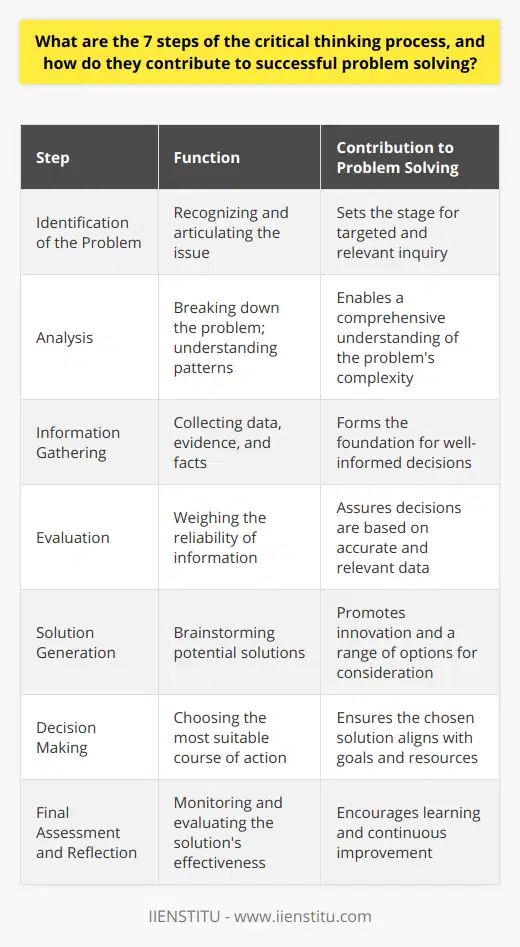
How do metacognition and self-awareness contribute to the development and enhancement of critical thinking and problem-solving skills?
Role of Metacognition and Self-Awareness
Metacognition can significantly enhance problem-solving and critical thinking abilities. It embodies the 'thinking about thinking' process. Understanding how one thinks improves decision-making efficacy. This insight fosters development of better strategies for learning and problem-solving.
Self-Awareness: A Tool for Development
In tandem with metacognition, self-awareness develops critical thinking. Recognizing personal thought patterns brings an opportunity to adjust them. This adjustment can lead to improved problem-solving abilities. It can also affect the person’s attitude towards challenges.
Harnessing Metacognition for Problem-solving
Metacognition fosters an understanding of personal thought processes. This understanding makes problem-solving more flexible and effective. Identifying strengths and weaknesses in strategies allows for modifications, improving the outcome. This highlights the significance of metacognition in problem-solving.
Metacognition and Self-Awareness: Enhancing Critical Thinking
Metacognition and self-awareness contribute to improving critical thinking abilities. By understanding how personal thoughts and beliefs affect decision-making, one can learn to adjust these factors. This adjustment allows for more objective and analytical thinking. With this, decisions become more balanced and justifiable.
Enriching Learning Experience with Metacognition
Applying metacognition to learning experiences enhances critical thinking skills. Reflective thinking on learning processes enables learners to identify knowledge gaps and understanding issues. Filling these gaps contributes to enhanced learning and sharper critical thinking.
Improving Problem-solving Strategies using Self-Awareness
By increasing self-awareness, one can improve problem-solving strategies. Knowing how personal thoughts and emotions impact decisions can lead to the development of more effective strategies. This understanding builds confidence and improves the quality of problem-solving.
In conclusion, metacognition and self-awareness play pivotal roles in developing and enhancing critical thinking and problem-solving skills. A deeper understanding of personal cognitive processes allows individuals to refine strategies, decision-making abilities, and learning experiences.
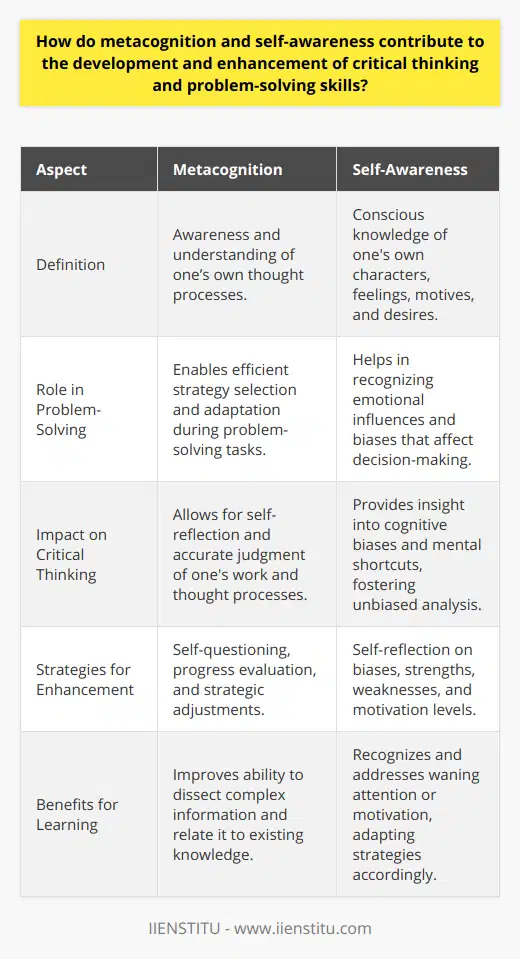
What role do heuristics and mental shortcuts play in critical thinking, and how can we minimize their potential negative impact on our problem-solving abilities?
Role of Heuristics in Critical Thinking
Heuristics are cognitive shortcuts or rules of thumb that simplify complex thought processes, quickening decision-making in daily life. In critical thinking, this strategy identifies pertinent information, guiding swift, efficient decisions. Precisely, these mental shortcuts accelerate problem-solving procedures, especially in unfamiliar or ambiguous scenarios.
Negative Impact of Heuristics
Despite their usefulness, heuristics can have detrimental effects if incorrectly applied. They can lead to cognitive biases, obstructing our judgement, hiding alternatives, inducing errors, and narrowing perspective. Essentially, relying on heuristics can sometimes cloud a fact-based assessment of the situation at hand, ultimately impairing our problem-solving capabilities.
Strategies to Minimize Negative Impact
Consequently, there are several strategies to minimize the negative impact of heuristics on our problem-solving abilities. Firstly, raise awareness about cognitive biases, which are often subconscious. Recognize occasions when heuristics take over, interrupting logical reasoning. Secondly, use reflective thinking. Pause, consider alternatives and view problems from various dimensions before making a decision. By doing so, decision-making becomes a more informed and thoughtful process. Finally, practice self-regulation. Steer clear of automatic responses and make conscious efforts to think critically, despite the mental effort it requires.
In conclusion, while heuristics are crucial in accelerating decision-making processes, their incorrect application may hinder effective problem-solving. However, through self-awareness, reflective thinking, and self-regulation, we can curb their potential negative impact, sharpening our critical thinking skills in the process.
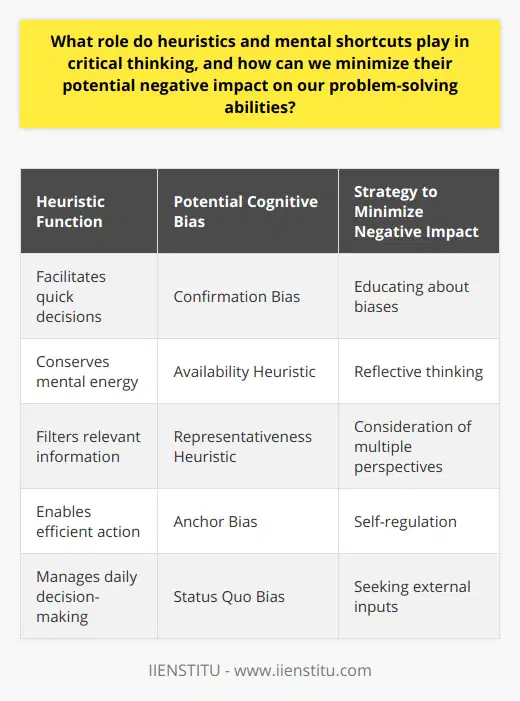
What is the relationship between critical thinking skills and problem-solving skills in academic and professional contexts?
Critical Thinking and Problem-solving: An Intricate Connection
Critical thinking and problem-solving abilities share a crucial relationship in academic and professional contexts. Essentially, critical thinking lays the foundation for effective problem-solving. It involves rationally analyzing and evaluating issues to form judgments. In academics, it offers a lucid understanding of complex concepts, enabling the development of effective strategies to solve problems.
Role of Critical Thinking in Problem-solving
Strong critical thinking skills help break down complex problems into manageable parts. This is a vital prerequisite for successful problem-solving. For instance, when confronted with a scientific problem, a student with developed critical thinking skills can effectively dissect the problem, weight different solutions and evaluate possible outcomes.
Correlation in Professional Contexts
Similarly, in the professional world, critical thinking and problem-solving go hand in hand. Professionals, like engineers or managers, often encounter challenges that demand swift and efficient resolutions. They deploy critical thinking to identify potential hurdles, consider various solutions, make informed decisions, and apply the most effective strategy. This approach yields constructive solutions in various situations, even amidst uncertainty and ambiguity.
Final Consideration: Self-reflection
Moreover, critical thinking promotes self-reflection—an asset in refining problem-solving skills. It impels individuals to question their assumptions and biases, facilitating the enhancement of their problem-solving strategies.
In summary, the ability to think critically accelerates problem-solving skills. The capacity to question, analyze, and evaluate situations in an academic or professional context dramatically improves one's ability to devise innovative, logical, and effective solutions to problems. Therefore, nurturing critical thinking skills can significantly enhance problem-solving ability, leading to more significant academic and professional achievements.
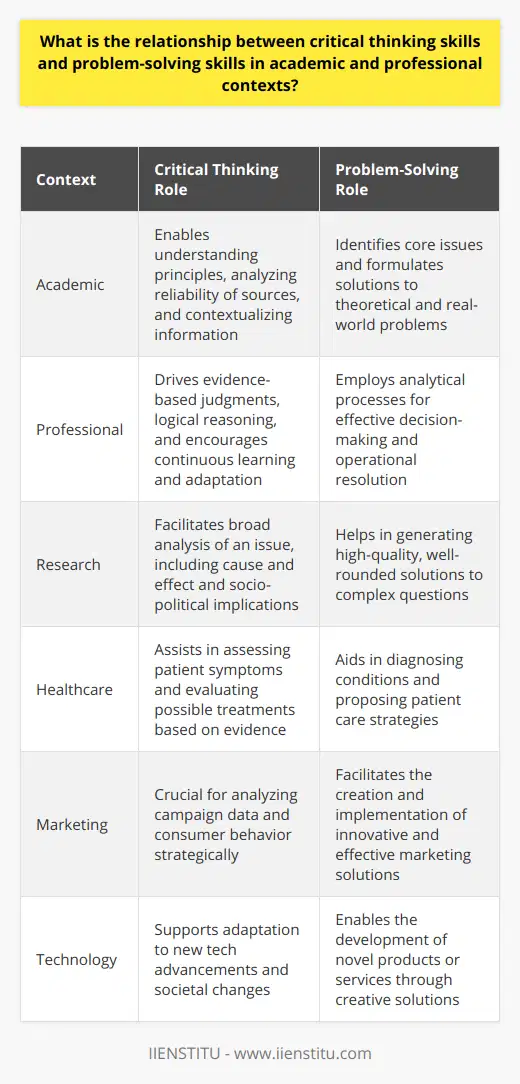
Why is it essential to continuously develop and refine our critical thinking skills throughout our lives and careers?
The Rationale for Enhancing Critical Thinking Skills
Critical thinking skills are pivotal in our lives and careers for various reasons. Primarily, a developed sense of critical thinking permits us to make well-informed decisions. It pushes us to analyze all aspects of a situation holistically before we form an opinion or take action.
Importance of Critical Thinking in Personal Life
In our personal sphere, it helps us to evaluate the pros and cons of any event, such as financial investments or medical procedures. Consequently, it empowers us to make superior choices that minimize risks and maximize potential benefits, promoting overall well-being.
Critical Thinking in Professional Environments
In our professional lives, critical thinking is equally, if not more, important. It is the heartbeat of problem-solving and decision-making, two indispensable skills in any workplace. When we encounter troublesome situations, we lean on our critical thinking abilities to dissect the problem, examine every facet, and brainstorm plausible solutions. Without it, we may resort to unproductive, rash decisions, causing potential organizational harm.
The Need for Continuous Development of Critical Thinking Skills
Despite the significance of critical thinking, we should not remain satisfied with the level of our present ability. The broader our experience and knowledge base, the stronger our ability to critically analyze, interpret, and make decisions. We should cultivate a lifelong learning attitude, consistently seeking to acquire new knowledge and experiences that help refine our critical thinking skills.
Conclusion
Thus, the continual development and honing of critical thinking skills are essential in both personal and professional domains. It enables us to make better decisions, resolve issues effectively, and enhance our overall quality of life. To stay relevant and adaptable in a rapidly evolving world, we must persistently nurture and sharpen our critical thinking skills.
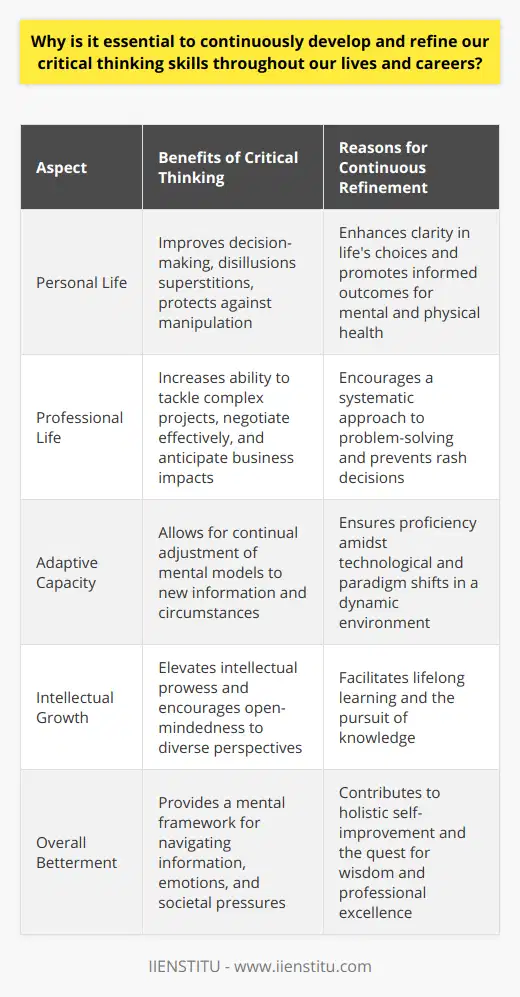
What strategies can be employed to overcome cognitive biases and foster an environment that encourages effective critical thinking and problem-solving?
Strategies to Address Cognitive Biases
Identifying cognitive biases is the first step to overcome them. Self-awareness fosters the ability to detect any subconscious bias. Regular self-reflection can aid in this process.
Mindful Decision-Making
Mindful decision-making is an effective strategy. It involves consciously slowing down the thought process, questioning assumptions, and analyzing outcomes. Viewing a problem from various angles can minimize cognitive errors.
Broadening Perspectives
Exposure to varied perspectives can also help. Diverse inputs and experiences can reduce cognitive biases. Collaborative problem-solving can facilitate this exchange of ideas.
Promoting Constructive Feedback
Constructive feedback is a powerful tool too. Feedback can provide a fresh outlook on biases. A culture of feedback exchange should be therefore nurtured.
Fostering Critical Thinking
Critical thinking goes hand in hand with problem-solving. Strengthening this skill can be achieved through consistent practice. Incorporating problem-solving exercises and scenarios can help.
Training in Logical Reasoning
Training in logical reasoning can be beneficial. It encourages individuals to factor in all elements of a problem. This results in decisions made on solid reasoning, not biases.
Use of Tools and Frameworks
Various tools and frameworks can assist in overcoming biases too. Tools like SWOT analysis or decision trees provide structured thinking paths. They direct focus towards objective information, minimizing the effect of biases.
In conclusion, overcoming cognitive biases requires proactive strategies. Mindful decision-making, exposure to varied perspectives, constructive feedback, critical thinking, logical reasoning, and use of tools and frameworks can play a significant role in fostering an environment conducive to effective thinking and problem-solving.
